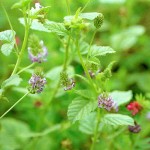Propagation Method of Psoralea Corylifolia
Family Name: Papilionaceae
English Name: Babchi Seeds
Hindi name: Babchi, Bhacaj
Bengali: Latakasturi Bavachi
Telugu Name: Bavanchalu
Tamil Name: Karpokarish
Psoralea Corylifolia is a common herbaceous weed is found in Bengal, Maharashtra and all over the plains of India. Seeds which have an agreeable aromatic order and pungent smell. Psoralea Corylifolia is propagated through seeds. Seeds should be treated with one percent of sulfuric acid for 1 hour, and then the seeds should be repeatedly washed in water before the seed is sown. The land should be ploughed throughout before the onset of monsoon. The seeds are planted at a distance of 50 to 60 cm apart. The field is kept free from weeds by regular weeding. To control the insect and pest, spray the crop with 1% roger twice in a month.
The crop takes about 8 to 9 months to reach maturity. When the crop reaches at ripe stage, single seeded fruit turns brownish to black and emits a mild odour. An average yield of 1000Kg of dry seeds per acre can be obtained. For 1 acre of land 3kg of Psoralea Corylifolia seeds are required. Continue reading
Propagation Technique of Aralia Elegantissima
Aralia Elegantissima also called Araliaceae is an evergreen ornamental shrub. It grows to 1.8 to 2.4m in height with erect stem. Aralia Elegantissima tolerates 6.0 pH to 7.5 pH. These plants are excellent for a cool shady climate and can be kept in indoors.
Propagation of Aralia Elegantissima (Araliaceae)
Seeds treated with sulphuric acid for 30 to 40 minutes are used for propagation. Use liquid manure of cow dung when the plants are kept in outdoor.
Liquid manure of Cow Dung
Take fresh cow dung approximately 100 gm. The same is put into muslin bag and tied. Muslin bag is then suspended in a bucket containing 1 litre of water and allowed to ferment for 2 to 3 days (the same should not be stored for a prolonged period more than 3 days). A dark coloured liquid results from the water soluble part of the dung. The concentrated suspension is further diluted with water to get a very light tea coloured solution. That is it. Continue reading
Propagation Methods of Cochlospermum Gossypium
Uses of Cochlospermum GossypiumA native of India, Myanmar and some island of archipelago. It is found all over India from Bihar, Orissa and Himalayan tracks up to 3000 feet elevation. The plants are grown near Indian temples for its decorative
Crataeva Religiosa
Crataeva Religiosa is usually cultivated in Central India, Bengal and Assam found near streams in Malabar in Kerala. It is also common in Myanmar and Sri Lanka.
Description of Tree
Small medium sized, much branched deciduous trees with crooked branched leaves and compound flowers which are white pale and yellowish. It is suitable for ornamental planting in Public Park and open space in towns. It can stand severe drought and is suitable for dry area.
Parts Used
Bark leaves and root bark.
Uses in Ayurveda
Bark is especially useful for urinary complaints such as kidney, bladder stone, fever and to relieve from vomiting. For bruise fresh leaves of Crataeva Religiosa grinded well with a little vinegar or lime water or hot water and applied to the skin as paste, Continue reading
Uses of Cynodon Dactylon
English name: Bermuda grass, Dog grass, Hurvallee grass, ahama Grass, Couch Grass, Devil’s Grass, Indian Doab, Grama, and Scutch Grass CynodonDactylon is found in Africa, India. It is cultivated throughout the tropics and subtropics as a fodder for livestock. Cynodon Dactylon was introduced into Georgia by 1751 and has spread throughout the world.
Parts used for human use are: Herb and root stalk
Action: Fresh juice is demulcent, astringent and diuretic. Plant is acid, hemostatic and loxative.
Uses of Bermuda Grass
The expressed juice of fresh Cynodon Dactylon grass is applied to cuts and wounds as it stops bleeding, for this purpose brushed grass may be applied. Cynodon Dactylon has got the capacity to purify blood by eliminating toxins from the blood. It removes general weakness. Juice when sniffed up in case of epistaxis proves a valuable styptic and stops bleeding. Fresh juice is used also in case of dropsy, anasarca, chronic diarrhea and dysentery. Cold fusion of the grass stops bleeding from piles; it is generally given with milk. The plant is used for the cure for scorpion sting. The medicinal properties of Cynodon Dactylon includes antimicrobial and antiviral properties Continue reading
Propagation method of Tinospora Cordifolia
Tinospora Cordifolia is a plant found mainly in Malaysia, India and Srilanka. The main parts uses of this plant are stem and root. It is a large highly spreading, woody climber with fat are water-retaining plants adapted to arid climate or soil conditions.
Uses of Tinospora Cordifolia
Tinospora Cordifolia can be used for scorpion sting treatment. An infusion prepared from the stem and root is a valuable toxic in debilitating diseases. Its is used to cure skin problems, fever weakness, jaundice and diabetes. It is used for piles. The extract of Tinospora Cordifolia is very effective against the insect Aphis Craccivora Koch (aphid). This can be used as a natural way of killing insects in garden.
Cultivation of Tinospora Cordifolia
Medium black soil or red soil is the best for the cultivation of Tinospora Cordifolia. A well drained, rich in organic matter soil is very good for the growth of this plant. The plant is very hardy and it can be grown in almost all climates but prefers warm climate.
Tinospora can be propagated by seeds and also vegetative cuttings. The best way is vegetative way. The cuttings of the small finger thickness with 6 to 8 inch length long stem having two nodes are used. The cuttings are dipped by quick dip method in 2500 ppm of IBA and get greater success of rooting. This may be planted in poly bags of 4 inch ×6 inch size. The poly bags filled with mud, sand and dry cow dung in the ratio 1:1:1. The rooting of the cuttings takes almost 4 to 5 weeks. The cuttings of Tinospora Cordifolia will be ready for planting into the main field by this time. Continue reading
Ayurvedic Treatment for the Removal of Dandruff
There are a lot of methods of treatment for the dandruff in Ayurveda. These methods which are mentioned below can be considered as the natural remedies to get rid of dandruff.
1. Take green gram and make it into powdered form. Mix the same with curd and rub it on the hair and keep it for 5 minutes and then wash it with warm water. This will help in the removal of dandruff.
2. Heat olive oil and rub it into the scalp. This will clear the dandruff.
3. Take Ocimum tenuiflorum, piper bettle and ixora. Grind these entire things in a grinder without adding water. Boil the grinded paste with coconut oil. Proportion is 1:1:1 and oil 2 part. Filter the contents and rub the extract on the hair. After 10 minutes take a shower and clean the oil.
4. Azadirachta indica leaf should be boiled in water and then cooled. Wash the head with this cooled water removing the leaves of Azadirachta indica. Continue reading






